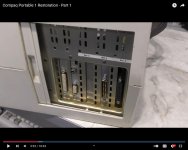Thank you. I will save this in case I become interested in that in the future.I had been planning to write something up on the subject for a while.
I have started that - see [here].
Refers to using FDISK /MBR. Yes, that was the problem. Once I used FDISK /MBR, the 512 MB. card works fine in the XTIDE board.Maybe the problem is the first one listed at [here].
I think this takes care of almost everything that I want to do with the Compaq Portable 1 before I "permanently" close it up. The only two things left I can think of are taking a picture of the XTIDE board, writing down the settings (and stuffing a written copy of the settings in the power cord compartment), and attaching an access LED. I just ordered 4 status LEDs (enough for other XTIDE boards plus screw-ups) with 12-inch wires and jumper connectors from Mouser. What I can do is route it to the grill above the XTIDE board expansion slot, and twist-tie it to the inside of the grill. That will make it visible from the outside without modifying the case at all, or risking being smashed by the Portable 1's sliding door. See this screenshot from the 8-Bit Guy.

I can do a similar access LED placement inside the front grill of the Epson Apex 1.
Last edited:
